The assignor estoppel doctrine (“AED”) is an equitable doctrine based on the principle of fair dealing that prevents assignors of patent rights, and those in privity with them, from challenging the validity of the assigned rights under many circumstances. The classic fact pattern in which the AED is invoked involves an inventor/assignor assigning his or her patent rights for value and then seeking to invalidate such patent rights when sued for infringement of the assigned rights.
The Supreme Court has recognized this doctrine on a number of occasions, but each time, it has done so sparingly and has tightly constricted it.[1] The Federal Circuit, on the other hand, has considerably broadened its application beyond that which the Supreme Court has recognized.[2] The AED is now again before the Supreme Court in Hologic.[3] Given the Supreme Court’s prior jurisprudence, many expect the Supreme Court will eliminate the AED in its entirety and, if not, severely restrict its application.
In either event, patent rights assigned in an asset purchase agreement or the like will now, in many or all instances, be subject to attack for invalidity by the very entity from which they were purchased or any other assignor, including, e.g., the inventor(s). To limit its exposure, the assignee may want to consider including or strengthening protective provisions in the applicable agreement similar to those that were adopted in license agreements following the Medimmune[4] decision allowing licensees to challenge licensed patent rights while retaining their licensed rights.
Provisions to consider include the following: (i) a deferred payout structure; (ii) non-compete or exclusivity clause with an extended term; (iii) representations & warranties with an extended survival period; and (iv) patent challenge provisions including a definition of “challenge” sufficiently broad to encompass both court and patent office proceedings including an inter partes review (“IPR”), advance notice of and grounds and support for the challenge, payment of assignee’s fees or costs incurred in defending a challenge, and payments and other penalties if the challenge is successful. A provision simply prohibiting a challenge is not viable, as such a provision has long been held to be unenforceable as being contrary to the important public policy of eliminating invalid patents.[5]
For existing agreements, some limited protection for the assignee/buyer may be found in the representations and warranties and exclusivity or non-compete clause (though likely of shorter duration than one would like) typically included in asset purchase agreements or similar transactions involving an assignment of patent rights.
Contrary to its holdings with respect to the AED and district courts, the Federal Circuit has recently held that the AED does not apply in IPR proceedings before the US Patent and Trademark Office (“PTO”).[6] Thus, regardless of how the Supreme Court rules on the AED in Hologic, a patent assignee may want to consider including protective provisions in any transaction involving an assignment of patent rights to deter challenges at the PTO.
Even with appropriate protective provisions, challenge concerns will remain in those instances where a chain of assignors/assignees exists, particularly if an assignor, e.g., an inventor, in the chain is not employed by or otherwise affiliated with the last entity to assign the patent rights at issue. Short of entering into separate agreements with these individuals or entities, there is little an assignee can do to protect itself from a patent challenge by such an individual or entity.
Endnotes
1 See Westinghouse Elec. & Mfg. Co. v. Formica Insulation Co., 266 U.S. 342 (1924), Scott Paper Co. v. Marcalus Mfg. Co., Inc., 326 U.S. 249 (1945), and Lear, Inc. v. Adkins, 395 U.S. 653, 666 (1969).
2 See, e.g., MAG Aerospace Indus., Inc. v. B/E Aerospace, Inc., 816 F.3d 1374 (Fed. Cir. 2016), Mentor Graphics Corp. v. Quickturn Design Sys., Inc., 150 F.3d 1374 (Fed. Cir. 1998), Carroll Touch, Inc. v. Electro Mech. Sys., Inc., 15 F.3d 1573 (Fed. Cir. 1993), Shamrock Techs., Inc. v. Med. Sterilization, Inc., 903 F.2d 789 (Fed. Cir. 1990), and Diamond Sci. Co. v. Ambico, Inc., 848 F.2d 1220 (Fed. Cir. 1988).
3 Minerva Surgical, Inc. v. Hologic, Inc., et al., No. 20-440, 2021 WL 77248 (U.S. Jan. 8, 2021).
4 MedImmune, Inc. v. Genentech, Inc., 549 U.S. 118 (2007).
5 See, e.g., Kimble v. Marvel Entm’t, LLC, 135 S. Ct. 2401 (2015), Blonder-Tongue Labs., Inc. v. Univ. of Ill. Found., 402 U.S. 313 (1971), and Edward Katzinger Co. v. Chi. Metallic Mfg. Co., 329 U.S. 394 (1947).
6 Arista Networks, Inc. v. Cisco Sys., Inc., 908 F.3d 792, 804 (Fed. Cir. 2018).




 />i
/>i

